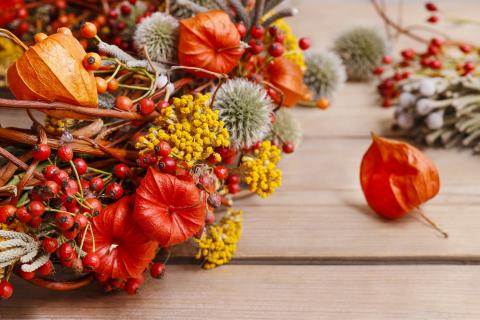Chinese Lantern
The bright orange paperies of the Chinese lantern (Physalis alkekengi) add a pop of color to any fall bed, and are popular in floristry.
Factsheet
- Growth type
-
- Perennial plant
- Growth height (from)
- from 60 cm to 80 cm
- Growth width (from)
- from 30 cm to 40 cm
- Growth characteristics
-
- upright
- foothills
- bushy
- Flower color
-
- white
- Flowering time (month)
-
- July to September
- Flower shape
-
- terminal
- small
- unimpressive
- Leaf color
-
- green
- page format
-
- 3-7 pieces
- heart-shaped
- Sheet properties
-
- Autumn coloring
- Light
-
- sunny to semi-shade
- Soil type
-
- sandy to loamy
- Soil Moisture
-
- dry to fresh
- ph value
-
- neutral
- Lime compatibility
-
- lime-loving
- Nutrient requirements
-
- moderately nutritious
- Humus
-
- rich in humus
- Decorative or utility value
-
- Fruit ornaments
- Toxicity
-
- toxic
- Winter Hardness
-
- hardy
- Use
-
- Flowerbeds
- Bouquets
- Garden style
-
- cottage garden
- Flower garden
There are lanterns hanging all around the garden in fall. The Chinese Lantern (Physalis alkekengi), an old garden perennial, adds a pop of color to the perennial bed with its cordate sinuate sepals in a bright shade of orange-red. The plant is part of the Physalis genus (Greek for “bladder”), a nightshade (Solanaceae). Its name refers to the genus’ common characteristic: the striking sepals that form around the mature fruit. These are also popular in floristry.
This genus has around 90 species, most of which come from North and South America. The Chinese lantern originally spread from Asia to the South of Europe, and is the only one to appear in the wild in central Europe. There are two varieties: Physalis alkekengi originally comes from South Europe to West Asia and grows up to 12 to 24 inches tall. Physalis alkekengi var. franchetii (sometimes also called P. franchetii) is more commonly available to buy. This plant comes from East Asia and grows up to 39 inches tall.
The Chinese Lantern’s main flowering period is between July and September. The cream-yellow to white star-shaped flowers make it easy to spot this plant as a member of the nightshade family. After flowering, the sepals grow together and form the plant’s characteristic lanterns that light up fall with their shades of orange to brick-red. As the sepals decompose into a kind of skeleton, the small berries inside become visible. The Chinese Lantern has green stems that become woody at the base, and can grow up to 20 to 39 inches tall, depending on the variety. The entire plant is toxic.

Chinese Lanterns prefer a sunny to partially shaded and limey location with sandy-humus, fresh, nutrient-rich soil.
This perennial needs more water in sunny locations. However, the Chinese Lantern does not tolerate waterlogging.
Forming thick stock, the Chinese Lantern is ideal for cottage gardens. It’s particularly well suited for the edges of woodland or unused corners of the garden. Companion plants should be sufficiently competitive. Day Lilies (Hemerocallis), tall Bellflowers (such as Campanula persicifolia) or loosestrife (Lysimachia punctata) are good options. Decorative foliage (such as Miscanthus) or dwarf comfrey (Symphytum grandiflorum) are good partners – particularly around compost heaps.
The best time to plant is spring. From February/March, seeds can be sown and grown on windowsills or in cold frames. Simply sprinkle a little compost into the hole and add some grit to prevent the soil from compacting. Water the Chinese Lantern well to make it easier for the plant to establish in its new location. As the plant tends to sprawl, it’s advisable to use a root barrier down to a depth of 20 to 24 inches in small gardens to prevent its spread from becoming a problem. It should ideally be planted in wild groups of perennials or corners of the garden where its spread will not cause an issue.
It’s also possible to grow these plants in pots as long as good winter protection is provided. Once planted out and established well, this perennial is winter hardy in temperate zones. In colder zones, it can be covered with sticks. The Lanterns do not just lose their color over winter but also their structure. The remaining skeleton structure is, however, still attractive in its own right.

It is important that the stems of this perennial are cut back no earlier than spring as these protect the overwintering plants from the effects of frost. Dead or spreading shoots can be cut in the main growing season. Use sharp garden shears to keep injuries to the plant as minimal as possible.
As this perennial is very prone to propagating itself, the gardener does not have to think about propagation. Species can be propagated through sowing seed, while varieties require dividing.
Apart form aphids and root rot, no other harmful insects or fungal infections are known to affect Physalis alkekengi. If the leaves of young Chinese Lanterns show white to brown discoloration and begin to wilt, this is often just a sign that the plant is not tolerating direct sunlight and must get used to its location.

This nightshade doesn’t just look good in the garden: this perennial can be used as a long-lasting cut plant for countless decorative projects in fall. The red Lanterns can be dried as well to decorate windows or make bouquets, arrangements and wreaths all winter long. To dry this plant and its characteristic leaves, simply put the cut stems in a vase with a little water in early fall. This way, the sepals will dry very slowly and retain their bright orange-red color.

